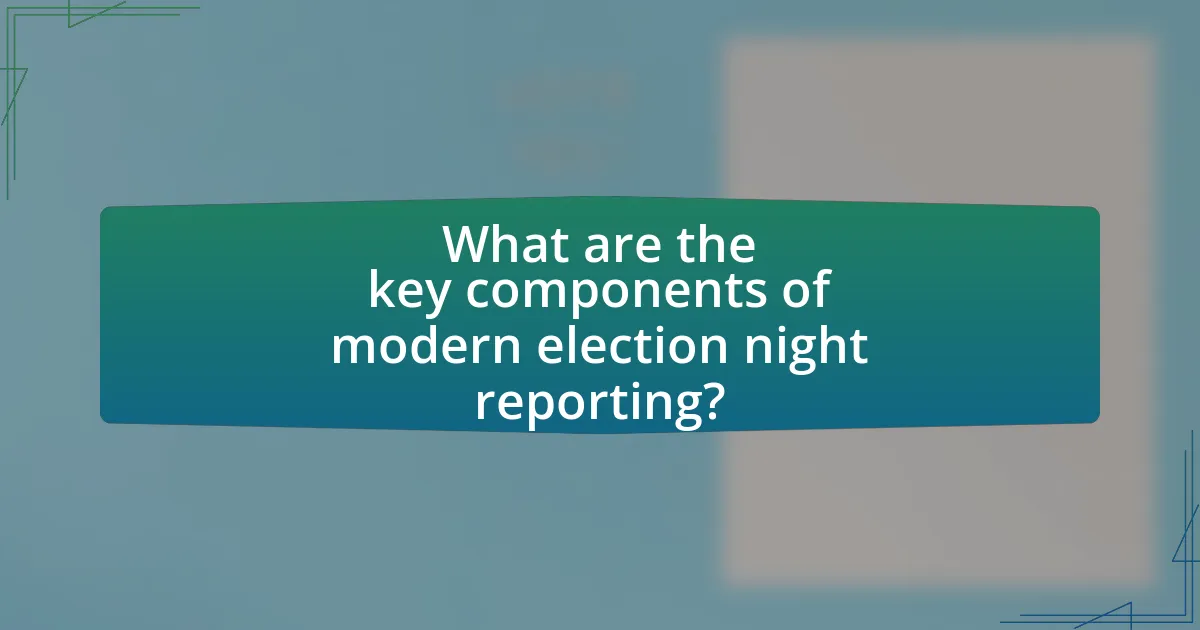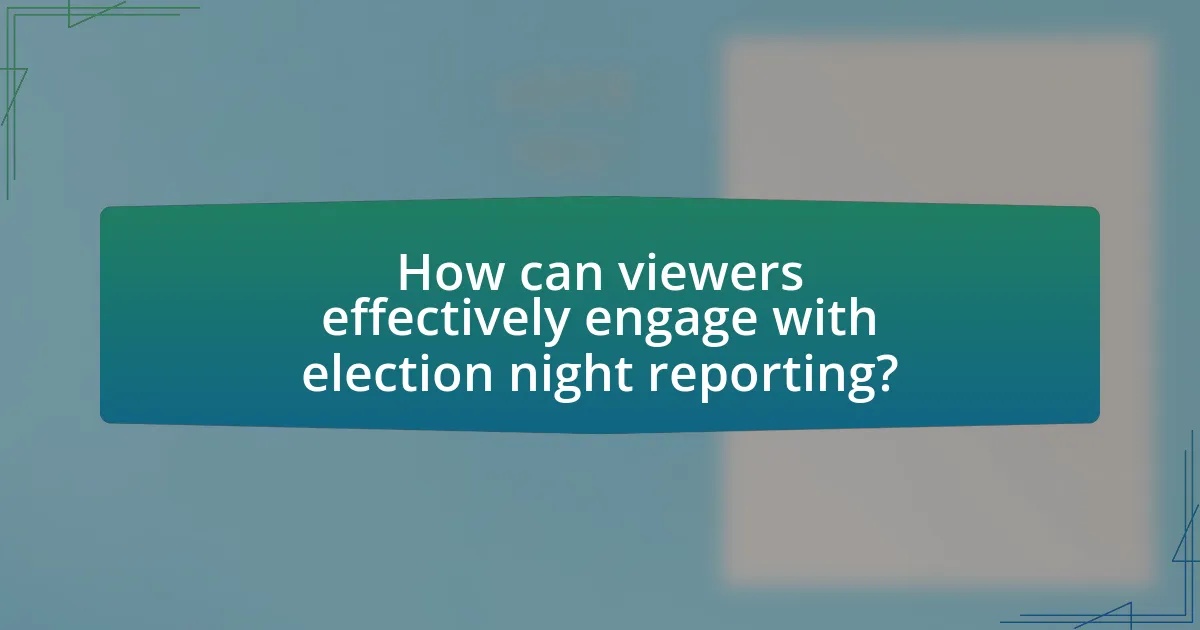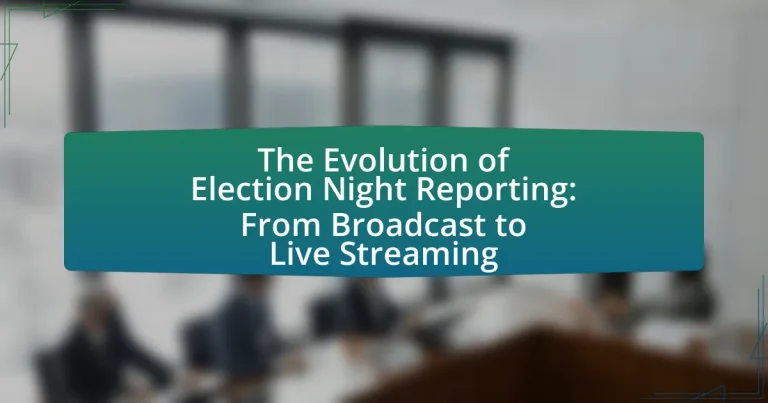The article examines the evolution of election night reporting, highlighting the transition from traditional broadcast methods to real-time live streaming. It outlines key milestones in the history of election reporting, including the introduction of telegraph, radio, and television, leading to the rise of the internet and social media platforms. The discussion emphasizes how technological advancements have enhanced the immediacy, accuracy, and interactivity of election coverage, while also addressing the challenges broadcasters face in adapting to these changes. Additionally, the article explores the role of data analytics, audience engagement, and future trends shaping the landscape of election night reporting.

What is the Evolution of Election Night Reporting?
The evolution of election night reporting has transitioned from traditional broadcast methods to real-time live streaming. Initially, election results were reported through radio and television broadcasts, with networks relying on exit polls and delayed counting to inform the public. As technology advanced, the introduction of the internet allowed for faster dissemination of information, leading to the rise of live streaming platforms. This shift enabled news organizations to provide immediate updates and interactive features, enhancing viewer engagement. By 2020, major networks utilized social media and digital platforms to reach broader audiences, reflecting a significant change in how election results are communicated.
How has election night reporting changed over the decades?
Election night reporting has evolved significantly over the decades, transitioning from traditional broadcast methods to real-time digital platforms. In the 1960s and 1970s, networks relied on telephone calls and exit polls to report results, often leading to delays and inaccuracies. By the 1980s and 1990s, the introduction of computer technology allowed for faster data processing and more accurate reporting, with networks beginning to use graphics and maps to visualize results.
The 2000s saw the rise of the internet, enabling news organizations to provide live updates and interactive features, enhancing viewer engagement. Today, social media platforms and live streaming services dominate election night coverage, allowing for instant updates and audience interaction, reflecting a shift towards immediate and accessible information dissemination. This transformation has been driven by advancements in technology and changing viewer expectations for timely and interactive content.
What were the key milestones in the history of election night reporting?
Key milestones in the history of election night reporting include the first use of telegraph reporting in the 1840s, which allowed for real-time updates on election results. In 1920, radio broadcasting marked a significant advancement, as KDKA in Pittsburgh aired the first live election results. The introduction of television in the 1950s further transformed reporting, with CBS and NBC providing extensive coverage of the 1960 election. The 2000 election saw the rise of the internet, enabling news websites to offer live updates. Finally, the advent of social media platforms in the 2010s allowed for instant sharing of results and voter engagement, marking a new era in election night reporting.
How did technological advancements influence election night reporting?
Technological advancements significantly transformed election night reporting by enabling real-time data analysis and instant communication. The introduction of digital platforms and social media allowed news organizations to provide live updates, engage with audiences, and disseminate results more rapidly than traditional broadcast methods. For instance, the use of data visualization tools and interactive maps has enhanced the clarity and accessibility of election results, allowing viewers to understand complex information at a glance. Additionally, the integration of mobile technology has facilitated on-the-ground reporting, enabling journalists to share updates directly from polling places, which was not possible in earlier election cycles. These advancements have collectively increased the speed, accuracy, and interactivity of election night reporting, reflecting a shift from static broadcasts to dynamic, real-time coverage.
What role did traditional broadcast media play in election night reporting?
Traditional broadcast media served as the primary source of information for election night reporting, providing real-time updates and analysis to millions of viewers. Historically, networks like ABC, CBS, and NBC dominated the landscape, utilizing their resources to project results, conduct interviews, and offer expert commentary. For instance, during the 2008 U.S. presidential election, CNN’s use of a hologram to present interviews exemplified how traditional media adapted to engage audiences while delivering timely information. This reliance on broadcast media established a framework for public discourse and shaped voter perceptions, making it a crucial element in the electoral process.
How did television shape public perception of election results?
Television significantly shaped public perception of election results by providing real-time coverage and analysis, influencing how viewers interpreted outcomes. The introduction of televised election night broadcasts in the 1960s, particularly during the Kennedy-Nixon election, marked a pivotal moment; it allowed audiences to witness live updates and expert commentary, which framed their understanding of the electoral process. Studies show that televised coverage can sway public opinion, as seen when networks called states based on exit polls, leading to shifts in voter sentiment and behavior. This immediate access to information created a sense of urgency and engagement, ultimately altering the public’s relationship with electoral outcomes and the political landscape.
What were the limitations of broadcast media in reporting elections?
Broadcast media faced several limitations in reporting elections, primarily due to time constraints, lack of depth, and accessibility issues. Time constraints often resulted in superficial coverage, where complex electoral processes were oversimplified into brief segments, failing to provide comprehensive analysis. Additionally, broadcast media typically focused on major candidates and parties, neglecting smaller parties and independent candidates, which limited the diversity of viewpoints presented to the audience. Accessibility issues also arose, as not all demographics had equal access to broadcast media, particularly in rural or underserved areas, leading to unequal information dissemination. These limitations hindered the ability of broadcast media to deliver a complete and nuanced picture of the electoral landscape.
Why is live streaming becoming the preferred method for election night reporting?
Live streaming is becoming the preferred method for election night reporting due to its immediacy and interactivity. This format allows news organizations to provide real-time updates and engage directly with viewers through comments and social media integration, enhancing audience participation. According to a 2020 Pew Research Center study, 53% of Americans reported using online platforms for news, indicating a significant shift from traditional broadcast methods. Additionally, live streaming enables journalists to cover events as they unfold, offering a more dynamic and responsive reporting style that aligns with the fast-paced nature of election results.
What advantages does live streaming offer over traditional broadcasting?
Live streaming offers real-time interaction and accessibility that traditional broadcasting cannot match. Unlike traditional broadcasting, which has a fixed schedule and limited viewer engagement, live streaming allows audiences to participate through comments and reactions, fostering a sense of community. Additionally, live streaming can be accessed on various devices and platforms, reaching a broader audience without geographical limitations. According to a report by Statista, live streaming viewership has increased significantly, with over 80% of consumers preferring to watch live content due to its immediacy and interactivity. This shift highlights the growing preference for live streaming as a more engaging and flexible alternative to traditional broadcasting.
How has audience engagement changed with the rise of live streaming?
Audience engagement has significantly increased with the rise of live streaming. This shift allows real-time interaction between viewers and content creators, fostering a sense of community and immediacy. For instance, platforms like Twitch and YouTube Live report that chat features enable viewers to comment and ask questions during broadcasts, enhancing participation. According to a 2021 report by StreamElements, live streaming viewership grew by 99% year-over-year, indicating a strong preference for interactive content. This evolution in audience engagement reflects a transition from passive consumption to active involvement, fundamentally changing how audiences connect with live events, including election night reporting.

What are the key components of modern election night reporting?
The key components of modern election night reporting include real-time data analysis, interactive graphics, and multi-platform broadcasting. Real-time data analysis allows news organizations to provide up-to-the-minute results as votes are counted, enhancing the immediacy of reporting. Interactive graphics engage viewers by visualizing data trends, such as voter turnout and demographic breakdowns, which help audiences understand the election landscape. Multi-platform broadcasting ensures that information reaches audiences through various channels, including television, online streaming, and social media, catering to diverse viewing preferences. These components collectively enhance the accuracy and accessibility of election night coverage, reflecting the technological advancements in media.
How do data analytics enhance election night reporting?
Data analytics enhance election night reporting by providing real-time insights into voter behavior and election trends. By analyzing data from various sources, such as exit polls, social media, and historical voting patterns, news organizations can deliver timely and accurate updates on election outcomes. For instance, during the 2020 U.S. presidential election, data analytics allowed networks to project results more quickly and accurately, utilizing algorithms that processed millions of data points to identify trends and predict outcomes. This capability not only improves the speed of reporting but also increases the reliability of the information presented to the public, thereby enhancing the overall election night experience.
What tools are used for real-time data analysis during elections?
Real-time data analysis during elections is primarily conducted using tools such as data visualization software, statistical analysis platforms, and social media monitoring tools. Data visualization software like Tableau and Power BI enables analysts to create interactive dashboards that display live election results and trends. Statistical analysis platforms, such as R and Python libraries, allow for complex data modeling and predictive analytics to interpret voting patterns. Additionally, social media monitoring tools like Brandwatch and Hootsuite track public sentiment and engagement in real-time, providing insights into voter behavior and reactions. These tools collectively enhance the accuracy and immediacy of election reporting, facilitating informed decision-making and public communication.
How do data visualizations impact viewer understanding of election results?
Data visualizations significantly enhance viewer understanding of election results by presenting complex data in an accessible and interpretable format. These visual tools, such as graphs, charts, and maps, allow viewers to quickly grasp trends, comparisons, and outcomes that would be difficult to comprehend through raw data alone. For instance, a study by the Pew Research Center found that visual representations of data can improve retention and comprehension by up to 80%, demonstrating their effectiveness in conveying information. Additionally, visualizations can highlight key insights, such as voter turnout and demographic shifts, which are crucial for understanding electoral dynamics.
What platforms are leading the way in live streaming election coverage?
YouTube, Facebook, and Twitter are leading platforms in live streaming election coverage. YouTube has become a primary source for real-time updates and analysis, with major news organizations and independent creators broadcasting live events. Facebook facilitates interactive engagement through live videos and community discussions, allowing users to share and comment on election-related content. Twitter serves as a real-time news feed, where journalists and news outlets provide live updates and commentary, making it a vital platform for immediate information dissemination during elections. These platforms collectively enhance voter engagement and information accessibility during election cycles.
How do social media platforms contribute to election night reporting?
Social media platforms significantly enhance election night reporting by providing real-time updates and facilitating immediate engagement between voters and news outlets. These platforms allow news organizations to disseminate live results, share analysis, and interact with audiences through comments and shares, creating a dynamic information environment. For instance, during the 2020 U.S. presidential election, platforms like Twitter and Facebook were pivotal in broadcasting live updates, with Twitter reporting over 40 million tweets related to the election on the night itself. This immediate access to information and the ability to engage with diverse viewpoints contribute to a more informed electorate and a more interactive reporting process.
What role do news websites play in live streaming election coverage?
News websites serve as crucial platforms for live streaming election coverage by providing real-time updates, analysis, and interactive features that engage viewers. They enable audiences to access live feeds of election results, expert commentary, and data visualizations, enhancing the overall understanding of the electoral process. According to a Pew Research Center study, 61% of Americans reported using online sources for election news in 2020, highlighting the significant role these websites play in shaping public awareness and participation during elections.
What challenges do broadcasters face in the transition to live streaming?
Broadcasters face several challenges in the transition to live streaming, including technical infrastructure, audience engagement, and monetization strategies. The technical infrastructure challenge involves ensuring reliable internet connectivity and sufficient bandwidth to support high-quality streaming, as traditional broadcasting does not require the same level of digital resources. Audience engagement is another significant hurdle, as broadcasters must adapt their content to attract and retain viewers in a more fragmented digital landscape, where competition from various platforms is intense. Additionally, monetization strategies need to evolve, as traditional advertising models may not translate effectively to streaming platforms, necessitating new approaches to revenue generation. These challenges are critical for broadcasters to address in order to successfully transition to live streaming and maintain their audience reach.
How do technical issues affect live streaming during elections?
Technical issues significantly disrupt live streaming during elections by causing interruptions, delays, and loss of viewer engagement. For instance, problems such as server overloads, bandwidth limitations, and software malfunctions can lead to buffering or complete outages, which hinder the timely dissemination of election results. Historical examples include the 2020 U.S. presidential election, where various streaming platforms experienced technical difficulties, resulting in frustration among viewers and impacting the overall perception of the electoral process. Such disruptions not only affect the immediate viewing experience but can also undermine public trust in the electoral system and the media’s ability to report accurately and efficiently.
What strategies can be implemented to overcome these challenges?
To overcome the challenges in election night reporting transitioning from broadcast to live streaming, media organizations can implement several strategies. First, investing in robust technology infrastructure ensures reliable streaming capabilities, which is crucial for maintaining audience engagement during high-traffic events. For instance, platforms like YouTube and Facebook Live have demonstrated the ability to handle large viewership spikes effectively.
Second, training staff in digital journalism techniques enhances the quality of reporting, allowing for real-time updates and interactive content that resonates with online audiences. Research indicates that audiences prefer engaging formats, such as live chats and social media interactions, which can be integrated into live streams to foster viewer participation.
Third, establishing partnerships with tech companies can provide access to advanced analytics tools, enabling organizations to better understand viewer behavior and preferences. This data-driven approach allows for tailored content that meets audience expectations, thereby improving overall viewer satisfaction.
Lastly, diversifying content delivery across multiple platforms ensures broader reach and accessibility, accommodating various audience preferences. By employing these strategies, media organizations can effectively navigate the complexities of modern election night reporting.

How can viewers effectively engage with election night reporting?
Viewers can effectively engage with election night reporting by utilizing multiple platforms for real-time updates and interactive features. Engaging through social media allows viewers to participate in discussions, share opinions, and access diverse perspectives, enhancing their understanding of the election process. Additionally, using live streaming services provides instant access to results and expert analyses, which can be complemented by interactive maps and data visualizations that illustrate voting trends and outcomes. Research indicates that 70% of voters prefer to follow election results through digital platforms, highlighting the shift from traditional broadcasting to more dynamic, participatory forms of reporting.
What tips can enhance the viewing experience during election night?
To enhance the viewing experience during election night, viewers should utilize multiple screens to access various news sources and platforms simultaneously. This approach allows individuals to compare different analyses and updates, ensuring a comprehensive understanding of the unfolding events. For instance, using a television for live broadcasts while simultaneously checking social media feeds and news websites can provide real-time updates and diverse perspectives. Additionally, engaging with interactive features, such as live polls or chat functions on streaming platforms, can foster a more immersive experience. According to a 2020 Pew Research study, 53% of Americans reported using multiple devices to follow election coverage, highlighting the trend towards a multi-platform viewing strategy that enhances engagement and information retention.
How can viewers verify the accuracy of information presented during live streams?
Viewers can verify the accuracy of information presented during live streams by cross-referencing the details with reputable news sources and fact-checking organizations. For instance, during live election coverage, viewers can consult established outlets like the Associated Press or Reuters, which provide real-time updates and verified information. Additionally, platforms such as FactCheck.org and Snopes offer tools to assess the credibility of claims made during live broadcasts. This approach ensures that viewers can discern factual information from potential misinformation presented in the live stream.
What are the best practices for following multiple sources during election night?
To effectively follow multiple sources during election night, prioritize using a combination of reputable news outlets, official election websites, and social media platforms. This approach ensures a comprehensive view of real-time updates and results. Reputable news outlets like CNN, BBC, and Associated Press provide verified information, while official election websites offer accurate data directly from election authorities. Social media platforms, such as Twitter, can provide immediate updates and insights from journalists and analysts. According to a Pew Research Center study, 53% of Americans reported using multiple sources for news during elections, highlighting the importance of diverse information channels for accuracy and context.
What future trends can we expect in election night reporting?
Future trends in election night reporting will increasingly focus on real-time data analytics and interactive platforms. As technology advances, news organizations will likely utilize artificial intelligence to analyze voting patterns and predict outcomes more accurately, enhancing the speed and reliability of information dissemination. Additionally, the rise of social media will continue to shape how results are shared, with platforms enabling live updates and audience engagement through polls and discussions. Historical data shows that in the 2020 U.S. elections, social media platforms played a crucial role in real-time reporting, indicating a shift towards more dynamic and participatory forms of election coverage.
How might emerging technologies shape the future of election coverage?
Emerging technologies will significantly shape the future of election coverage by enhancing real-time data analysis and audience engagement. Innovations such as artificial intelligence and machine learning can process vast amounts of electoral data quickly, providing insights into voter behavior and predicting outcomes with greater accuracy. For instance, AI-driven analytics can analyze social media trends and sentiment, allowing news organizations to tailor their coverage to audience interests and concerns. Additionally, advancements in live streaming technology enable more interactive and immersive experiences, allowing viewers to engage with the coverage through polls, Q&A sessions, and personalized content. This shift towards a more dynamic and responsive format reflects the growing demand for immediate and relevant information in the digital age.
What role will audience interactivity play in future election reporting?
Audience interactivity will play a crucial role in future election reporting by enhancing engagement and providing real-time feedback. As election reporting evolves from traditional broadcasting to live streaming, platforms will increasingly incorporate interactive features such as polls, live chats, and social media integration. This shift allows audiences to participate actively in discussions, share their opinions, and influence the narrative of the coverage. For instance, during the 2020 U.S. presidential election, platforms like YouTube and Twitter saw significant user engagement through comments and live reactions, demonstrating the potential for audience interactivity to shape reporting. This trend indicates that future election coverage will prioritize audience involvement, making it more dynamic and responsive to public sentiment.




